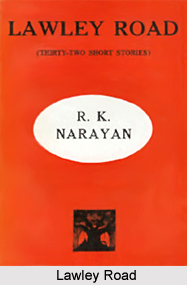 The Author R. K. Narayan was a prolific writer. In this collection of short stories `Lawley Road` one of the stories was Lawley Road. The municipality of Malguri decides to rename the town`s streets and institutions to reflect nationhood. And thus the previous Kabir Lane was changed to Lawley Road. The name of the storybook reflects the story of that part and truly unfolds the fact.
The Author R. K. Narayan was a prolific writer. In this collection of short stories `Lawley Road` one of the stories was Lawley Road. The municipality of Malguri decides to rename the town`s streets and institutions to reflect nationhood. And thus the previous Kabir Lane was changed to Lawley Road. The name of the storybook reflects the story of that part and truly unfolds the fact.
R. K. Narayan was a writer knows no bound. His language was for common people, for children as well as adults. He wrote for all class. In his make-believe village there were no castes, no politics, no quarreling. The people live a plain and simple life at that place. All engrossed in their own work. This village can give a fresh feel of any South-Indian village with a fragrance of Idly dosa and jasmine flower. He became capable of giving the impression of a village that is no were still people think that it is very much present in the world. In this book of his creation there are ample example of his great work. His description of changing the name of the `Coronation Park` to `Hamara Hindustan Park` is really enchanting. Many changes took place in the story and Narayan wonderfully explained all of them in a vivid manner. His descriptions were so clear that anyone could see the scenes as films. He will be remembered through generations though he left the world on 2001.
Synopsis:
In the title story of Lawley Road the Municipality of Malgudi decides to rename the town`s streets and institutions to reflect nationhood. This indicates the changes that take place in today`s cities like Madras has been changed to Chennai. Here Narayan is trying to say that change brings complication, which sometimes leads to a chaotic situation. As more places are renamed all its landmarks are gone haywire. The chairman of the municipality takes up a statue of Sir Frederick Lawley. The enormous, stubbornly solid statue is hacked away at great cost and effort, and ultimately removed with the aid of dynamite, only for the chairman to realize that Frederick Lawley had in fact been a virtuous governor who had advocated for India`s independence and died in the attempt to save villagers from drowning in a flood. The statue is restored in a new location, the name of which is being decided by the municipal council. The new place is Lawly Road, earlier name of which was the Kabir Lane. The story points comically to the way a political transition can alter not only a nation`s identity but also an individual`s sense of order.
Being published by Ind-Us the book `Lawley Road` is a collection of previous 33 but for present days 32 stories that are must read to any citizen.
Like any other books by R. K. Narayan, this Lawley Road also captivates imagination, making people smile about little wonders of life. This is an interesting book with a lucid and transparent writing style, which is the specialty of the author. The author R. K. Narayan manages to describe a simple person, his personality and his life in a small Indian town named Malgudi. After this book containing 32 short stories anyone can really identify one self in some situations, which are both comic and retrospective.



















